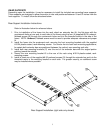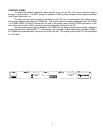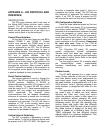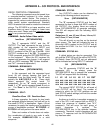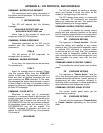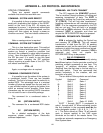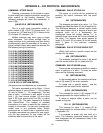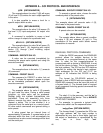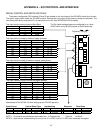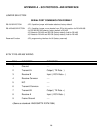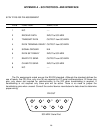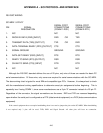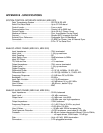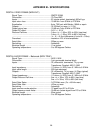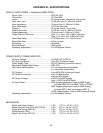APPENDIX A – SCI PROTOCOL AND INTERFACE
A6
@ZB {RETURN/ENTER}
The example above for salvo 2 (@) will erase
(Z) all level 2 (B) entries for each output specified
in the salvo.
It is also possible to erase a level for a
specific output within a salvo.
#ZC9 {RETURN/ENTER}
The example above for salvo 3 (#) erases (Z)
the level 3 (C) input assignment for output nine
(9).
A command is available to erase a level
within a range of outputs for a particular level.
#ZA12-19 {RETURN/ENTER}
The example above for salvo 3# will erase (Z)
all entries for level 1 (A), beginning with output
twelve (12) through (-)and including output
nineteen (19).
COMMAND: EXECUTE SALVO
A salvo can be executed immediately by
choosing the proper salvo symbol and using the
execute command.
!X {RETURN/ENTER}
The example above is the salvo 1 (!) execute
(X) command.
COMMAND: PRESET SALVO
The command to PRESET a salvo, but not
execute it, allows the system to queue a system
for an immediate preloaded switch upon the
execute command.
$P {RETURN/ENTER}
The example above for salvo 4 ($) presets
(P) and holds the salvo. During a salvo preset
condition, no other salvo can be accessed.
Neither edits nor system transactions are
permitted.
There are essentially only three
options: execute the salvo, cancel the salvo or
request a status. This is true whether it is a
command from the serial port or a control panel.
All other switch commands are ignored during a
salvo preset.
A salvo preset has an internal timer of
approximately 30 seconds. If a preset salvo is not
executed within this time, it will automatically be
canceled and a salvo cancel message will be sent
out the serial port.
COMMAND: EXECUTE PRESET SALVO
To execute a preset salvo, choose the salvo
number/symbol of the preset salvo.
$ {RETURN/ENTER}
The example above will execute salvo 4 ($),
which was in the preset mode.
COMMAND: CANCEL PRESET SALVO
A preset salvo can be canceled.
$Q {RETURN/ENTER}
The sample above takes a preset condition
for salvo 4 ($) and releases (Q, quit) it. This
cancellation of the preset salvo allows normal
transactions to resume.
RS422/485 PROTOCOL COMMANDS
Unlike the RS232 commands, the RS422/485
protocol allows for multiple devices to be
connected to a computer/terminal at the same
time. In order for the computer/terminal to
communicate with a device in RS422/485, it must
first tell the device to listen. This is the purpose of
the logic address. The SCI has four DIP switches
reserved for setting the device's logic address.
Valid addresses for the SCI are 01-07 (an
address of 00 indicates that RS-232 is being
used).
The format for RS-422/485 protocol is
identical to that of RS232 with one exception. Any
RS422/485 command must be have the prefix of
a forward slash (/). The forward slash is required
on all commands including special commands like
XON/XOFF.
/xx
The slash (/) is the precursor, and the 'xx' is
the logic address of the device. This is ALWAYS
a TWO DIGIT NUMBER.
For example, to generate a typical audio-
follow-video switch use the sequence below.
/xxIyyyOzzz {RETURN/ENTER}
The forward slash (/) precedes the SCI's two
digit logic address 'xx', the input number is
represented by one, two or three digits 'yyy' and
the output or destination is represented by the
one, two or three digit 'zzz'.



